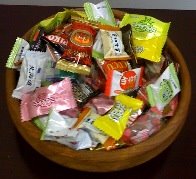 Candybowl first encountered Korean snack company Lotte in the early 1990's. They specialize in making knock-offs of famous candies, crackers, and cookies. It is therefore fitting that Lotte should be the ones to manufacture (apparently licensed) candies based on famous Japanese soft drinks.
Candybowl first encountered Korean snack company Lotte in the early 1990's. They specialize in making knock-offs of famous candies, crackers, and cookies. It is therefore fitting that Lotte should be the ones to manufacture (apparently licensed) candies based on famous Japanese soft drinks.Candybowl tried the CC Lemon, Bikkle, and Dekavita flavors.
CC Lemon should taste sour and lemony. But the candy version lacked real lemon flavor, and had an off note that Candybowl could not identify. Abrasive cleanser? Lemon Joy? Not good. And not sour, either.
Bikkle is a yogurt drink, The sweet's initial flavor, however, is of cotton candy. And although there was a slight sourness suggestive of yogurt, every time Candybowl tried to think of yogurt, memories of cotton candy rushed to the fore. The yogurt flavor did make a strong showing during the crunch test.
Dekavita had a nice citrus tone to it, but more off notes. Further citrus-scented household products came to mind. But the flavor was pleasant enough, and had a kind of sparkle on the tongue that compensated for some of the strange flavor notes.
None of the candies fared well in the crunch test. These boiled sweets fractured nicely, but then left an excessive amount of goo on the tooth.
These sweets have received good reviews from certain eaters, but Candybowl is not feeling a whole Lotte love.








